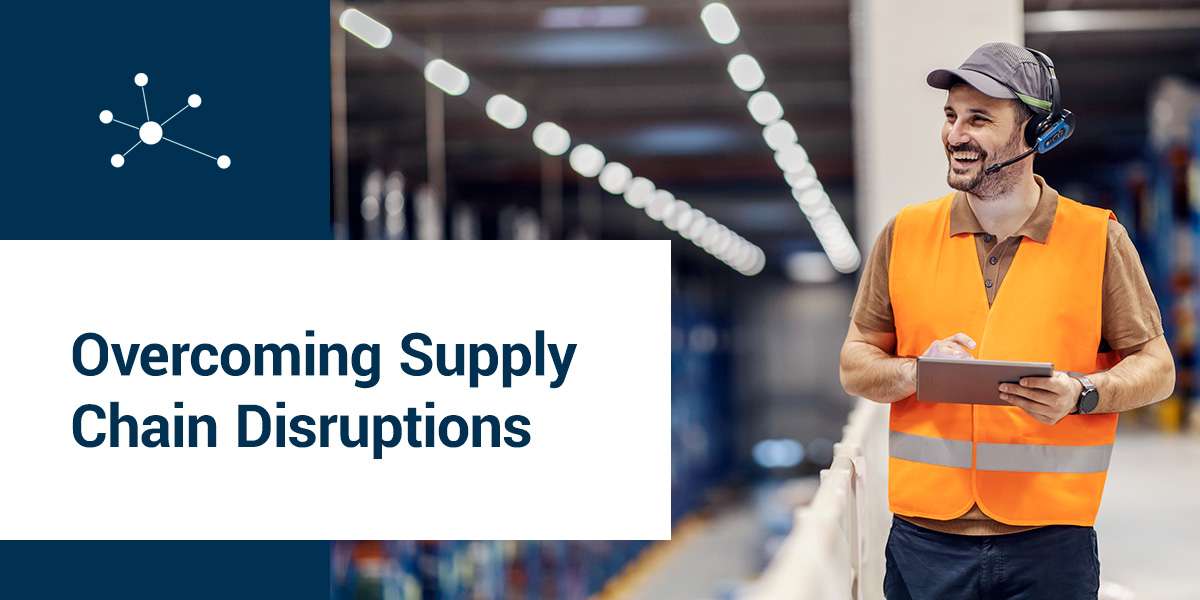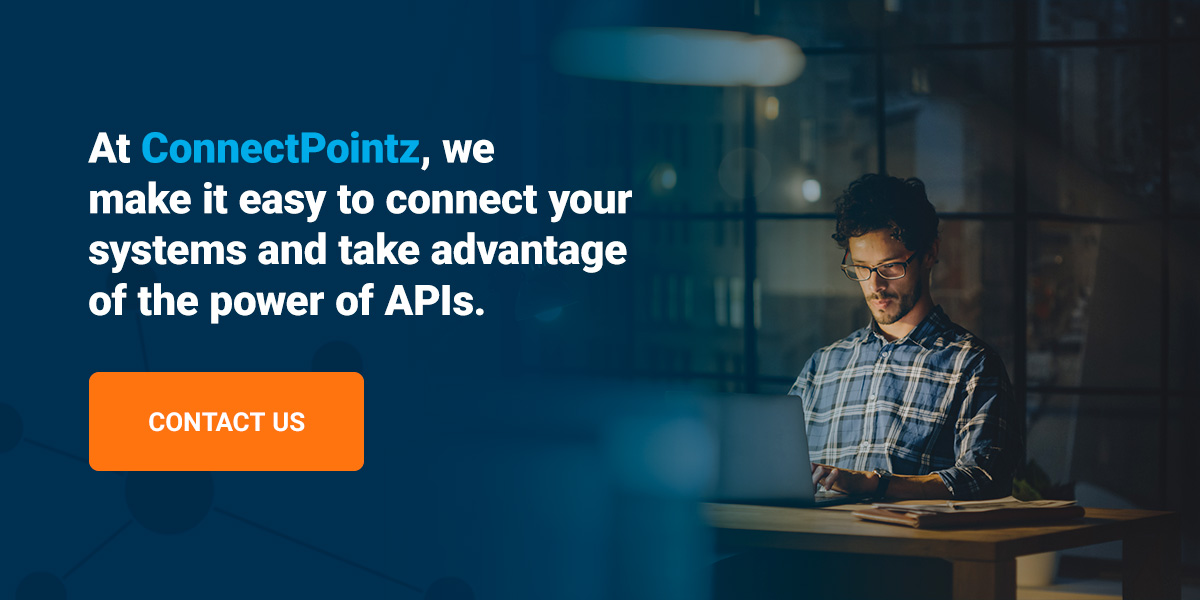
Today's fast-paced commerce environment calls for rich, sophisticated customer experiences supported by seamless back-end features. Headless commerce is an excellent way to achieve these technical goals, offering an approach that separates the frontends and backends of your commerce ecosystem and greatly simplifies IT demands.
With the help of resources like application programming interfaces (APIs) and experience managers, commerce businesses can take advantage of unparalleled flexibility, improved speed to market and many other benefits associated with headless commerce. Let's explore a detailed definition of headless commerce, its unique advantages and how you can start using this powerful approach to system architecture.
What Is Headless Commerce?
Headless commerce means decoupling the frontend of a platform — such as the text and images in an app or website — from the backend, which can include a wide range of functions from inventory and security systems to checkout tools. This approach helps to separate the complicated inner workings of a commerce system from the customer-facing elements.
These frontend elements must appear seamless and smooth to create a fast and modern experience for the user. Still, they often depend on information from larger, complex systems, such as inventory programs, customer relationship management (CRM) platforms and digital experience platforms (DXPs). If not separated, these systems become part of the overall infrastructure and can increase the challenges associated with offering the best solution for your customers, like slow websites and time-consuming modifications.
Most of headless commerce — and headless e-commerce — occurs with the help of APIs. APIs serve as messengers to bring requests and information to and from the frontends and backends. Say a customer is browsing your e-commerce storefront and wants to see if something is in stock. The frontend creates a request, and the API sends that request to the backend inventory management system. It then fetches the inventory details and returns them to the e-commerce storefront to present the information to the customer.
The result is a seamless, high-quality experience for the customer, who never sees the interaction between robust business resources on the backend. If they later check stock information from your store's mobile app, they can expect the app to pull from the same inventory system as the website did previously. APIs support modern, connected interactions for the omnichannel experience that today's customers expect.
Headless Commerce vs. Traditional Commerce
To understand the benefits of headless commerce, we need to compare it to traditional commerce. The traditional approach is a monolithic one. All functionality and customer experiences exist in a single system. Because everything is packaged together, IT teams can achieve extreme customization and control over the platform.
However, that control comes at a cost. Traditional commerce models are typically slow to go to market and don't adapt well to new features or designs. They require considerable development resources and expertise, which can increase costs and inhibit innovation. Traditional infrastructure may not allow for rich designs or merchandising either, limiting your ability to offer attractive, high-functioning customer experiences. You may be significantly limited in what kinds of changes you can make.
Another challenge with traditional commerce is the difficulty of integration. Your current systems might not play nicely in a traditional approach, and adapting the system can be difficult if your needs change. While a traditional system might initially seem simpler, it quickly becomes complicated at the enterprise level.
Headless commerce provides versatility and can use APIs to connect to many different sources. Plus, the APIs usually allow you to keep the programs that work for you while adding the extra functionality you're looking for. You can find APIs for just about any platform you might use in your business operations, such as:
- Payment processors.
- Inventory management systems.
- CRMs.
- Third-party selling platforms.
- E-commerce storefronts.
- Shipping service providers.
- Enterprise resource planning systems.
Headless commerce APIs allow you to bring data from these diverse platforms into one centralized space without the limitations of a monolithic approach. Developers can quickly incorporate new functions and designs without long release schedules. When responding to the fast-paced nature of commerce, businesses can use these capabilities to a significant advantage.
How Does Headless Commerce Work?
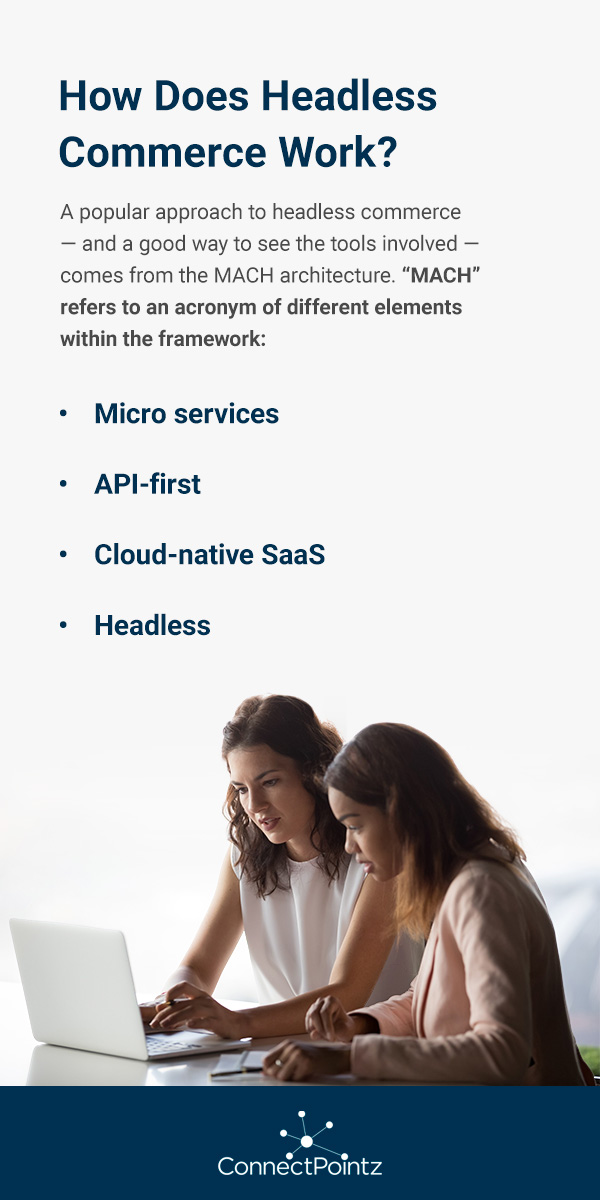
Headless commerce is a type of architecture in which APIs connect the front and back ends.
The frontend is also called the presentation layer. It can include everything from your storefront and website to social media channels, mobile apps and devices like voice assistants and self-serve kiosks. This layer makes up all of the touchpoints your customers might have in interacting with your system.
The backend includes all the hidden systems that keep things moving smoothly. You might use programs in this tech stack for merchandising, payment processing and fulfillment, among others. Other popular programs you'll find in the backend include CRMs, content management systems and DXPs. Usually acquired through a Software-as-a-Service (SaaS) model, these systems enable rich, complex interactions that transform how IT teams implement features and designs.
Because these two ends aren't linked, you can update your frontend, such as by redesigning your storefront or adding a featured product page, without touching the backend. Development demands are much lower. You can achieve greater customization and scale your business as needed to create positive customer experiences.
A popular approach to headless commerce — and a good way to see the tools involved — comes from the MACH architecture. This strategy allows you to create a flexible infrastructure with elements you can choose according to what works best for your goals. “MACH” refers to an acronym of different elements within the framework:
- Micro services: Micro services are independently developed, managed and deployed pieces of business functionality.
- API-first: MACH architecture relies on APIs to facilitate functionality.
- Cloud-native SaaS: SaaS solutions use the cloud for flexible scaling and automatic updates.
- Headless: Decoupling the presentation layer from the backend systems keeps things framework agnostic.
By focusing on these elements, businesses can better achieve flexible, agile systems.
The Benefits of Headless Commerce
Headless commerce's benefits can extend from business agility to improved customer experiences. Below are some of the biggest advantages of headless commerce platforms.
1. Flexibility and Customization
The unparalleled flexibility of headless commerce solutions allows you to create a platform as unique as you need it to be. You can give your customers fully individualized experiences that consider many different aspects of their interaction.
The result is a consistent and seamless experience. No matter what device or platform a customer uses, the information they see is powered by the same backend tools, providing cohesive access, accurate information and a consistent brand image across all interactions.
Headless commerce also creates flexibility through greater accessibility of different tools. While a monolithic architecture might require time-consuming development processes to implement a new feature, a decoupled system allows you to try new things, adding and removing elements without affecting other parts of the system. You can customize what you want to customize and rely on APIs and SaaS services to fill in the gaps.
2. Improved Customer Experiences
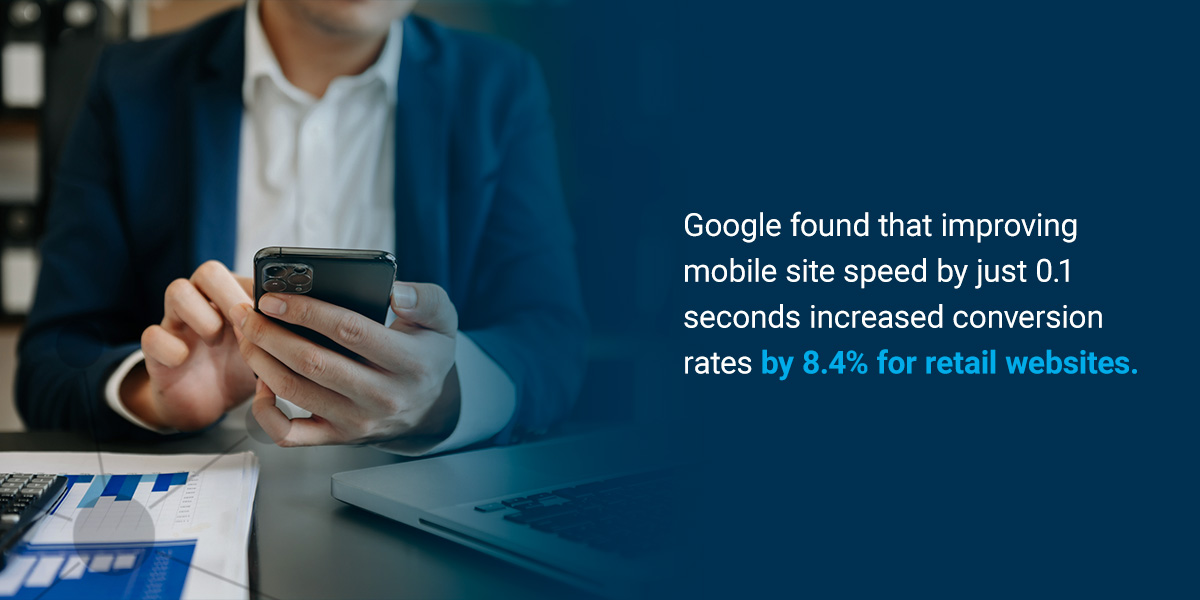
Separating the presentation layer from the backend supports a much richer, more flexible and dynamic experience for your users. Headless commerce allows you to create more attractive and complex experiences that appeal to your users, and the API-based design allows for faster load times. Slow load times can have a significant effect on bounce rates and user activity overall. For example, Google found that improving mobile site speed by just 0.1 seconds increased conversion rates by 8.4% for retail websites.
In addition to speed, headless commerce offers a more agile system that can accommodate new technologies and trends. For example, if a new payment platform appears, headless commerce models can quickly implement the platform and provide customers with a convenient, in-demand feature. You can stand out from the competition and build customer loyalty, all without cumbersome, inflexible development processes.
Overall, a headless commerce system can help you boost the customer experience to achieve benefits like more conversions, lower customer acquisition costs and improved organic traffic.
3. Improved Marketing Capabilities
Headless commerce can offer a wide range of marketing capabilities to help you learn from your customers and attract more of them. With easy access to sophisticated APIs, you can implement marketing tools like loyalty programs, social media sharing buttons and abandoned cart systems.
You can also use a headless system to collect more information on your customers and provide better solutions as a result. For instance, you might collect demographic data by using an API to communicate between customer account management tools and your CRM platform. Then, your CRM can compile the data and provide actionable insights to guide business decisions.
4. Ease of Development
Headless commerce is often much easier on developers. It reduces the demands on the IT team, particularly when deploying new features. Because you can make changes on one end without touching the other, modifications require far less coding and commitment from the IT team. This agile approach helps developers work more efficiently and focus on other tasks that require their expertise.
API-driven development further simplifies implementation thanks to pre-built integrations from major platforms. For example, many CMS and CRM platforms have pre-built APIs that quickly connect to your existing system. Developers don't need to build them from scratch, saving considerable time and energy.
Decoupled systems also allow for easier development by allowing IT teams to use the tools that work best for them. You aren't tied to an inadequate program due to its integration with the rest of your system. You can connect the right tools for the right kind of work.
5. Omnichannel Sales Tools
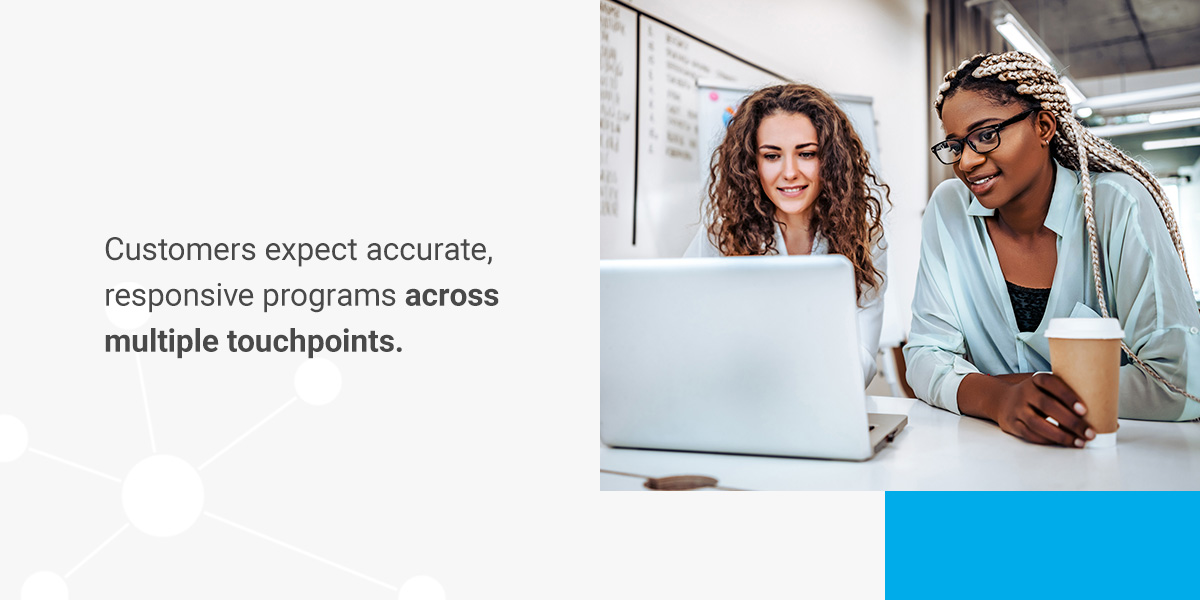
In today's interconnected digital world, an omnichannel approach is more important than ever. Whether customers are interacting with your store through an online storefront, social media platforms, mobile apps, in-store shopping or other channels, you must offer a cohesive experience. Customers expect accurate, responsive programs across multiple touchpoints. Headless commerce is crucial for integrating different channels with the same centralized backend system.
It facilitates fast speed to market for implementing these channels and allows you to create personalized experiences in each one. Many third-party channels offer APIs that are ready to connect to your platform. As you successfully incorporate additional channels, you can better meet consumer demands, attract new customers and expand your products to more places.
6. Support for Innovation
The unmatched agility of headless commerce can help you be an innovative player in your industry. Research tells us that innovative companies tend to thrive, particularly in areas of economics and risk mitigation. With more flexibility to adopt advanced technologies and hop on emerging trends, headless commerce puts you in the right position for innovation. You can test out new tech and free up developers to focus on new creations outside of the limitations of your existing platform.
You can create new front-end features, revolutionize content delivery and easily modify your frontend. Whether you want to keep things fresh for your audience, test out concepts for certain segments or adjust your storefront for new geographies, headless commerce offers easy innovation. The flexibility of headless commerce allows you to make business decisions with fewer limitations and greater confidence.
7. Scalability
Similarly, headless commerce can grow with your business, allowing you to ramp up operations as needed without significant staffing or technology requirements. With a monolithic approach, increasing capacity might require increasing the size of your IT team and spending time drastically reworking your existing infrastructure. APIs and decoupled architecture let you quickly adjust either side or implement new tools to accommodate your growth.
Headless Commerce API Solutions
Most businesses will use a vast collection of APIs in their headless commerce approach. Managing them all and ensuring seamless connections can be a challenge, which is where API integration tools come in handy.
An API integration platform facilitates communication between software applications. As the name suggests, this primarily happens through APIs. An integration tool enables more advanced integration so you can work with complex data exchanges or a high number of connected platforms.
With an API integration tool for headless commerce models, you can:
- Create your own APIs.
- Connect cloud-based applications.
- Reuse existing workflows and business logic for new features.
- Enable monitoring, administration and product configuration.
- Automate tasks and reduce manual entry requirements.
- Enjoy end-to-end data visibility.
Headless commerce relies heavily on APIs, and an integration tool helps you make the most of them for a seamless system with centralized data.
Contact ConnectPointz
Decoupling your front and back end systems can do wonders for business agility, allowing you to quickly implement new features, improve your team's efficiency and provide a top-tier customer experience. At ConnectPointz, we make it easy to connect your systems and take advantage of the power of APIs. Our API integration platform puts our decades of experience to work in managing and building APIs for your headless commerce model.
Our pre-configured and custom solutions allow us to find the right fit for your business. We have APIs from many platforms like BigCommerce, Shopify, Salesforce, Amazon and NetSuite available for frontend and backend systems. Reach out today to see how ConnectPointz can help you dive into headless commerce!





